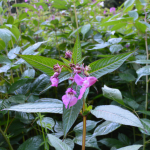We may be starting to feel like we are slipping into fall, with the crisp morning air, earlier sunsets and fall gardening tasks, but it’s no reason to let our guard down when it comes to invasive plants. Indeed, lots of invasive plants in our region are still active and setting seeds in September, so we must remain vigilant to avoid inadvertently spreading them.
Let’s take a closer look at some of them, and how you can help prevent their spread.
Seedy September Invasives
If you’ve driven along the Sea to Sky Highway between Vancouver and Squamish, you’ve most likely come across Butterfly Bush. In September, the pointed clumps of purple flowers are maturing into small, oval pods that contain 500-1000 seeds per pod. The seeds are winged, so they can cover significant distances in the wind!
Butterfly Bush is an extremely prolific seed producer, and its seeds are spread by wind, water, vehicles, equipment and machinery. Contaminated soil and the horticulture trade also play an important role in its spread, so be sure to adopt PlantWise principles when you garden at home!
Himalayan Balsam (Policeman’s Helmet) is actually an annual plant, meaning that it goes from seed to seed in one growing season.
As a result, the plant spends most of its energy and resources growing stems and producing flowers/seeds, rather than forming deep roots. As a result, its root system is extremely shallow – but don’t pull it in September!
At this point in the season, the flowers and seeds are already present, and any disturbance to the plant would scatter the seeds. Indeed, Himalayan Balsam seeds grow in capsules that, at maturity, split and eject the seeds up to 6 m away!
Besides, since Himalayan Balsam is an annual plant, the individual plants that you might encounter this season will soon die off; you are better off reporting a sighting if you find a new patch, and planning to remove it next year.
Watch out for Burdock‘s prickly burs! They will stick to clothes, pets, animals – anything that brushes by! Did you know that Burdock’s burs were a source of inspiration for Velcro’s inventor?
When dealing with Burdock in the fall, you need to take the seedheads’ ability to stick to nearly everything into consideration.
- You must have a plan for how you are going to dispose of the Burdock plant material: it needs to go into the household garbage, NOT the compost.
- Along the same lines, it is extremely risky to leave cut burdock stalks on the ground, regardless of whether it is soil or pavement: the seedheads remain ticking time bombs that will be spread into the environment.
Spotted and Diffuse Knapweed are easily distinguishable in late summer and early fall by their small, pineapple-shaped flowers.
Both invasive Knapweed species are prolific seed producers – one plant can produce up to 40,000 seeds in a season! Since seeds can remain viable in the soil for upwards of 8-15 years, Knapweed infestations rapidly form a seed bank.
Knapweed seeds spread in the wind but also in contaminated hay or soil, or by clinging to animals and vehicle undercarriages.
What does this mean for treatment and control?
When it comes to invasive plant control, our first preoccupation is preventing further spread. For invasive plants that are already setting seed, this means:
- Do not disturb the plants and seeds (by digging, gardening, walking too close to them, etc)
- Wanting to pull up some weeds? Focus on evergreen species, rather than ones that are bearing seed pods right now. You can use your observations to report a sighting and plan a weed pull for next season.
Disposal Recommendations
How you dispose of invasive plant material is critical to reducing the spread of invasives in our environment. Please remember to:
- Separate invasive plant material from yard waste
- Place invasive plant material in a bag, or on a tarp, and seal it
- Take the load to the transfer station/landfill
- DO NOT COMPOST!
Recommendations for seed-bearing plants are somewhat species-specific. For instance:
- For larger seed capsules, such as Burdock‘s, it is crucial that you place the seedheads in a bag before putting it in the garbage.
- For plants that have seed capsules that ‘project’ their seeds, such as Himalayan Balsam, you are best to leave them alone at this time.
Please refer to our disposal recommendations webpage for more information, or don’t hesitate to contact us for species-specific information.
Links
We think you’ll also like
- Flowering Plant Anatomy 101
- Intro to iNaturalist
- Wildflowers – native vs invasive
- Follow us on social media – we are on Facebook, Instagram and Twitter!























Add Comment